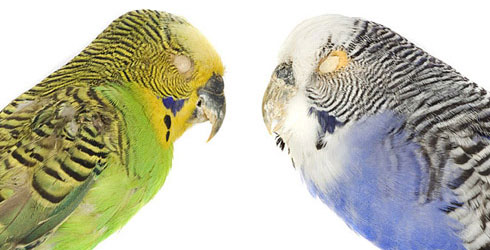Aviculture - budgerigar breeding
Budgies were first brought to Britain in 1840. Since then they have been bred in all shades and sizes.
Early budgerigar breeding
John Gould successfully imported the first live budgerigars to Britain in 1840, where they were received with great enthusiasm. In Birds of Australia, Gould wrote about his pair of captive budgerigars, noting how they had survived a hard voyage to Britain, around Cape Horn in winter! This pair had been captive-bred by Gould’s brother-in-law Charles Coxen, in Australia. More imports followed, and the birds became very popular.
The earliest known breeding in Britain was in 1848, in the aviaries of the 13th Earl of Derby at Knowsley Hall, near Liverpool. The Earl wrote to Gould in February 1848, telling him “we have been overjoyed here by the fact of a pair of the Melopsittacus undulatus breeding… we can hear the young”. The chicks unfortunately died soon after hatching, but one of them is preserved in the collections of the World Museum, Liverpool (Fisher and Warr, 2003).
Regular successful captive breeding developed in the late 1850s. There are several reports from this time and an advert for British birds offered for sale appeared in The Field in April 1859. Budgerigars were well established in captivity by the end of the 1870s, with their own exhibition classes at cage bird shows (Rogers and Blake, 2001).
Colour breeding
One of the reasons for the outstanding popularity of budgerigars is the huge range of colour varieties. Hundreds of varieties have been recorded, combining many different colours, patterns and other features. Like the domestic pigeons studied by Charles Darwin (1809–1882) as he developed his ideas on evolution, captive budgerigars are a fantastic example of artificial selection, showing how many different varieties can be developed from a single ancestral species.
The first ‘new’ colour found in budgerigars was yellow, recorded in 1872. There are occasional reports of yellow birds in the wild, but it was only in captivity that the colour could be artificially selected for. Blue budgerigars were the next to appear; blue birds were first exhibited in 1910 and caused a sensation. But there were problems establishing new colours, as no one really understood how to breed them reliably.
The next step in captive budgerigar development was therefore enormously important to breeders, but is also an under-recognised great scientific achievement (Birkhead et al, 2003). Budgerigars became the subject of some of the earliest intensive research into the principles of inheritance genetics, first observed by Gregor Mendel in the 1860s.
The importance of Mendel’s research in plants showing that certain features - such as colour - are inherited, was not recognised until the early 1900s, when several scientists published work based on Mendel’s ideas. Dr Hans Duncker (1881–1961) of Bremen, Germany realised that the principles could be applied to budgerigars. Working with Vice-Consul Carl Cremer (1858–1938), he carried out a huge number of breeding experiments from 1925 to 1933, to discover how budgerigar colours and patterns were inherited. The detailed results of their research are still vital to budgerigar breeders today (Taylor and Warner, 1986; Elliot and Brooks, 1999).
In addition to colours, breeders have also selectively bred for physical characteristics such as size and feather length. Modern show budgerigars are much larger than wild birds, and have much longer feathers, which can give them a big-headed appearance. Features such as different types of crest have also been developed, and new varieties are still appearing.
